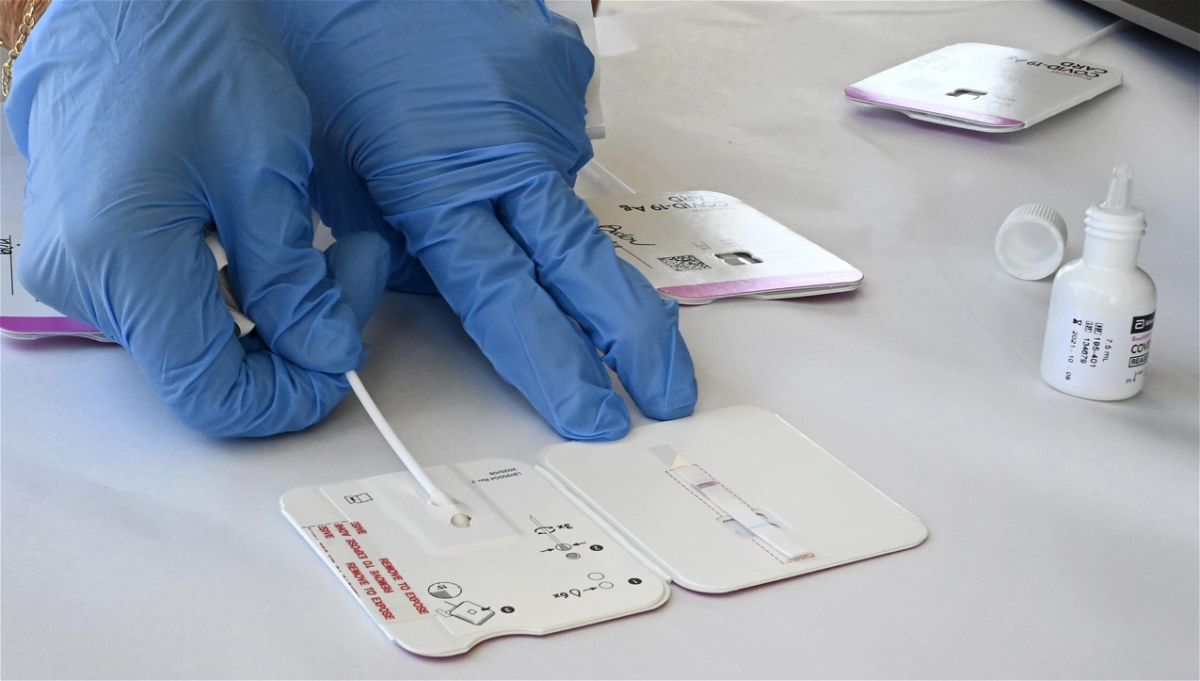‘Test-to-stay’ works to keep students in school safely, CDC director says

A rapid COVID-19 test swab is processed at Palos Verdes High School in Palos Verdes Estates
By Jacqueline Howard, CNN
New evidence shows that a practice known as test-to-stay works to keep children in classrooms safely, even if they’ve been exposed to the virus that causes Covid-19, said Dr. Rochelle Walensky, director of the US Centers for Disease Control and Prevention.
“Test-to-stay is an encouraging public health practice to keep our children in school,” Walensky said Friday during a virtual White House briefing.
When a Covid-19 case is identified in a school, a test-to-stay strategy uses regular testing instead of quarantining everyone who’s come into contact with that person, offering some relief for parents who have been overwhelmed with remote schooling during the pandemic. If the contacts don’t have symptoms and test negative for Covid-19 at least twice in a seven-day period, they can continue in-person learning, according to the CDC. If they test positive, they must isolate.
Over the past few months, the CDC has collaborated with certain school districts across the United States to evaluate test-to-stay programs.
On Friday, the agency published two studies in its Morbidity and Mortality Weekly Report (MMWR) on how schools have used test-to-stay to limit the spread of the coronavirus in classrooms while keeping students in attendance.
“CDC is updating our materials to help schools and parents know how to best implement this promising and now-proven practice, along with our multilayer prevention strategies that will help keep our children in the classroom safely,” Walensky said. “These studies demonstrate that test-to-stay works to keep unvaccinated children in school safely.”
Studying test-to-stay in schools
One of the new studies includes data on students and public schools in Los Angeles County between August 16 and October 31. In September and October, 432 schools implemented test-to-stay, and 1,635 did not.
The researchers from the Los Angeles County Department of Public Health found that among the schools that used test-to-stay, “Covid-19 incidence did not increase,” compared with schools that did not implement the strategy.
Before test-to-stay was adopted, the average daily student Covid-19 incidence was 10 cases per 100,000 students in districts that later implemented test-to-stay and 20 per 100,000 in non-test-to-stay districts, the data showed.
After test-to-stay was put in place, the researchers found that the average daily case rates among students declined in all school districts but remained lower on average in test-to-stay districts at 6 per 100,000, compared with 11 per 100,000 in non-test-to-stay districts.
Schools that did not implement test-to-stay “lost substantial in-person school days,” the researchers wrote in their study. But they added that “implementation requires resources that might be currently unavailable for some schools” and noted that “a higher percentage of disadvantaged schools” did not implement test-to-stay.
“The number one difficulty that I have heard, when I discuss these test-to-stay programs here in Maryland, is personnel,” Dr. Meagan Fitzpatrick, an infectious disease transmission modeler and assistant professor of medicine at the University of Maryland, told CNN in October. She wasn’t involved in the new study.
“When these school districts consider the test-to-stay program, what that requires is, it requires somebody to keep track of which students have been designated contacts of the first infection. And so it requires to track who those students are, and to track their test results every day, and to cross-check again that they’re getting their tests before they enter the school,” Fitzpatrick said.
“Particularly, the school nursing staff is already overstretched, and it seems that many of these districts face challenges in getting the additional staff that they would need.”
The other MMWR study, also published Friday, includes data on 90 schools across 31 school districts in Lake County, Illinois, that implemented test-to-stay programs between August 9 and October 29. During that period, 258 Covid-19 cases were reported, and 1,664 close contacts were reported.
The researchers — from the CDC, Rosalind Franklin University, and the Lake County Health Department — examined how many of the close contacts went on to test positive for coronavirus infection and whether the virus spread to any of the contacts’ contacts.
The researchers found that 16 of the close contacts tested positive for infection. All were students, and none appeared to transmit the virus to other contacts in school. However, a total of nine Covid-19 cases were identified among household contacts outside school, and four of the nine cases were in fully vaccinated people.
Overall, the researchers wrote, test-to-stay preserved up to 8,152 in-person learning days for the close contacts, and implementing test-to-stay “with multiple prevention components, including masking and physical distancing, resulted in low secondary transmission” of the coronavirus in K-12 schools in Lake County.
A layered approach
Michael Karner, Lake County’s regional superintendent of schools and a parent of two children, told CNN in October that test-to-stay programs have been successful at keeping kids in school safely if other mitigation measures, such as wearing masks, are in place.
“There must be appropriate, layered mitigation, such as social distancing and mask-wearing,” Karner said. “If those are not being followed, then the test-to-stay program would not work for those close contacts.”
In October, data from the test-to-stay program showed that for Lake County, fewer than 2% of kids exposed to the coronavirus in classrooms convert to a positive case, Karner said.
“Last year, we had lots of students — hundreds of students — quarantine just because they were close contacts. But this year, we found that we’ve been able to keep several hundred individuals that were contacts in schools, and we’ve also been able to get data with regards to exposure,” Karner said in October.
“Based on all the data that we’ve gotten in Lake County, we found out that exposure in the classroom is not leading to conversion, which means we’re not having many close contacts in the classroom,” he said. “Most of the close contact situations that we’ve had with regards to exposure have been on the bus and in the lunchroom.”
In Friday’s briefing, Walensky echoed the sentiment that other mitigation measures — such as mask-wearing — are needed for test-to-stay to be successful.
“In the test-to-stay protocol, there’s increased testing of close contacts after a Covid-19 exposure, and that testing needs to be at least twice during the seven-day period after exposure. If exposed children meet a certain criteria and continue to test negative, they can stay in school instead of quarantining at home,” she said.
“In order for test-to-stay to be implemented safely and correctly, some key prevention measures need to be included,” she said. “In both studies, masks were worn consistently and correctly, close contacts of a positive case were monitored for symptoms and stayed home if they became ill, and those who did not develop symptoms had regular testing.”
The-CNN-Wire
™ & © 2021 Cable News Network, Inc., a WarnerMedia Company. All rights reserved.

